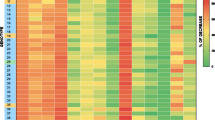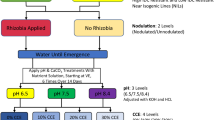Summary
Critical factors in the selection of appropriate screening procedures to detect different phenotypic responses to nutrient-deficiency stress are discussed. Various morphological, anatomical, and physiological plant factors responsible for adaptations to nutrient deficiency, particularly low-P stress, are reviewed. Also, the relative effectiveness of various screening culture techniques for detecting phenotypic efficiencies based on specific plant features are considered.
The relative ineffectiveness of liquid culture media in detecting plant factors critical in P acquisition from low-P natural environments is recognized, and a culture medium that is effective under these conditions is described. P adsorbed onto alumina, after mixing with coarse sand, serves as a P source in nutrient cultures. Buffered P concentrations approximating soil solution concentrations are maintained in this system, and P availability at the root surface seems diffusion-limited. With this system, significant differences in the growth of tomato strains under P stress were detected.
The desirability of screening phenotypes at the same degree of depression from maximum yield (equivalent deficiency stress) is discussed. The need for evaluations at equivalent stress is associated with the capacities of plants in general to respond to deficiency stress with morphological and physiological changes that may not be under genetic control, for example an increase in root:shoot ratio. Additional capacity to adjust the same plant factors often are characteristic of specific phenotypes. The relative growth of the same tomato strains under equivalent and non-equivalent P-deficiency stress is compared. Significant strain differences were observed under both conditions. However, the relative responses among strains for several efficiency parameters were very different under the two types of stress.
Similar content being viewed by others
References
Arnon D I and Johnson C M 1942 Influence of hydrogen ion cocnentration on the growth of higher plants under controlled conditions. Plant Physiol. 17, 525–539.
Arnon D I, Fratzke W E and Johnson C M 1942 Hydrogen ion concentration in relation to absorption of inorganic nutrients by higher plants. Plant Physiol. 17, 515–524.
Barber S A 1984 Soil Bionutrient Availability. John Wiley and Sons, New York.
Bhat K K S and Nye P H 1973 Diffusion of phosphate to plant roots in soil. I. Quantitive autoradiography of the depletion zone. Plant and Soil 38, 161–175.
Breeze V G, Canway R J, Wild A, Hopper M J and Jones L H P 1982 The uptake of phosphate by plants from flowing nutrient solution. I. Control of phosphate concentration in solution. J. Exp. Bot. 33, 183–189.
Chapin F S III 1980 The mineral nutrition of wild plants. Annu. Rev. Ecol. Syst. 11, 233–260.
Chapin F S III and Bieleski R L 1982 Mild phosphorus stress in barley and a related low phosphorus-adapted barley grass: Phosphorus fractions and phosphate absorption in relation to growth. Physiol. Plant. 54, 309–317.
Clement, C R, Hopper M J, Canway R J and Jones L H P 1974 A system for measuring the uptake of ions by plants from flowing solutions of controlled composition. J. Exp. Bot. 25, 81–99.
Coltman R, Gerloff G and Gabelman W 1982 Intraspecific variation in growth, phosphorus acquisition and phosphorus utilization in tomatoes under phosphorus-deficiency stress.In Proc. of Ninth Int. Plant Nutrition Colloq. Ed. A Scaife, pp. 117–122.
Coltman R R, Gerloff G C and Gabelman W H 1982 A sand culture system for simulating plant responses to phosphorus in soil. J. Am. Soc. Hort. Sci. 107, 938–942.
Coltman R R, Gerloff G C and Gabelman W H 1985 Differential tolerance of tomato strains to maintained and deficient levels of phosphorus. J. Am. Soc. Hort. Sci. 110, 140–144.
Coltman R R, Gerloff G C and Gabelman W H 1986 Equivalent stress comparisons for evaluating physiological and morphological differences among tomato strains differentially tolerant to P deficiency. J. Am. Soc. Hort. Sci. Submitted.
Coulombe B A, Chaney R L and Wiebold W J 1984 Use of bicarbonate in screening soybeans for resistance to iron chlorosis. J. Plant Nutr. 7, 411–425.
Coulombe B A, Chaney R L and Wiebold W J 1984 Bicarbonate directly induces iron chlorosis in susceptible soybean cultivars. Soil Sci. Soc. Am. J. 48, 1297–1301.
Epstein E and Norlyn J D 1977 Seawater-based crop production: A feasibility study. Science 197, 249–251.
Evans H J and Sorger G J 1966 Role of mineral elements with emphasis on the univalent cations. Annu. Rev. Plant Physiol. 17, 47–76.
Foehse, D and Jungk A 1983 Influence of phosphate and nitrate supply on root hair formation of rape, spinach and tomato plants. Plant and Soil 74, 359–368.
Giordano de B L, Gabelman W H and Gerloff G C 1982 Inheritance of differences in calcium utilization by tomatoes under low-calcium stress. J. Am. Soc. Hort. Sci. 107, 664–669.
Itoh S and Barber S A 1983 Phosphorus uptake by six plant species as related to root hairs. Agron. J. 75, 457–461.
Makmur A, Gerloff G C and Gabelman W H 1978 Physiology and inheritance of efficiency in potassium utilization in tomatoes grown under potassium stress. J. Am. Soc. Hort. Sci. 103, 545–549.
Mengel K and Kirkby E A 1982 Principles of Plant Nutrition. Int. Potash Institute, Worblaufen-Bern, Switzerland.
Nye P H 1977 The rate-limiting step in plant nutrient absorption from soil. Soil Sci. 125, 292–297.
Nye P H and Tinker P B 1977 Solute Movement in the Soil-Root System. Studies in Ecology. Vol. 4. Blackwell Scientific Publishers, Oxford, England.
O'Sullivan J, Gabelman W H and Gerloff G C 1974 Variations in efficiency of nitrogen utilization in tomatoes (Lycopersicon esculentum Mill.) grown under nitrogen stress. J. Am. Soc. Hort. Sci. 99, 543–547.
Shea P F, Gerloff G C and Gabelman W H 1968 Differing efficiencies of potassium utilization in strains of snapbeans,Phaseolus vulgaris L. Plant and Soil 28, 337–346.
Whiteaker G, Gerloff G C, Gabelman W H and Lindgren D 1976 Intraspecific differences in growth of beans at stress levels of phosphorus. J. Am. Soc. Hort. Sci. 101, 472–475.
Author information
Authors and Affiliations
Rights and permissions
About this article
Cite this article
Gerloff, G.C. Intact-plant screening for tolerance of nutrient-deficiency stress. Plant Soil 99, 3–16 (1987). https://doi.org/10.1007/BF02370149
Issue Date:
DOI: https://doi.org/10.1007/BF02370149




